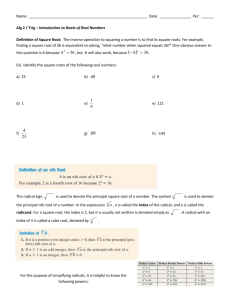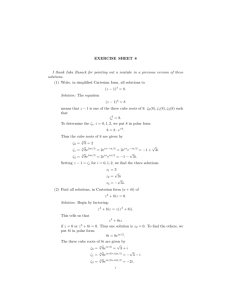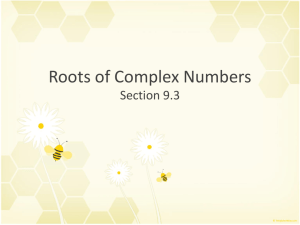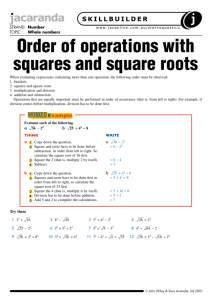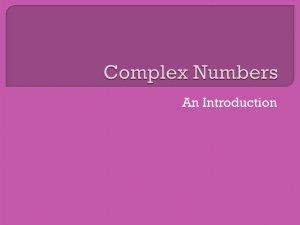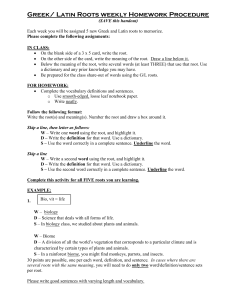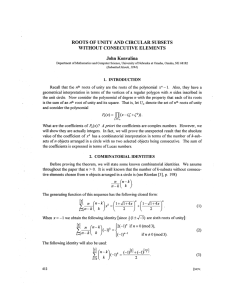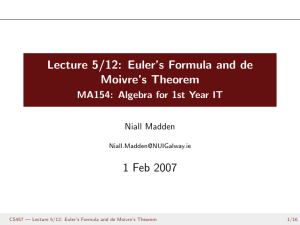Complex Numbers - Department of Physics
advertisement
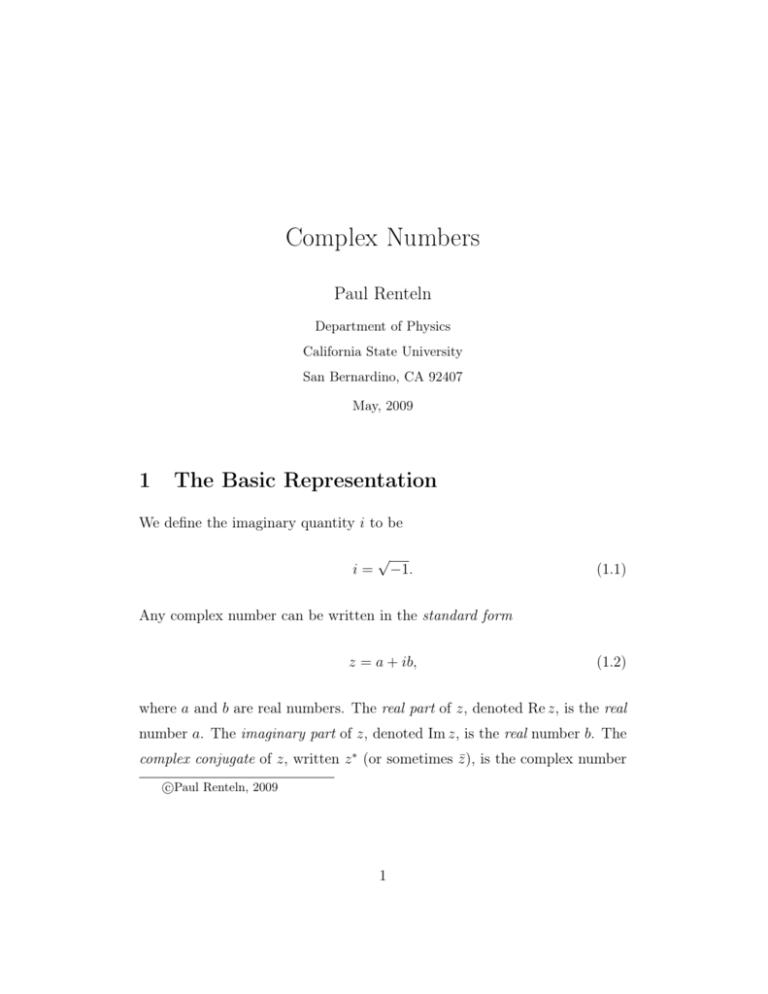
Complex Numbers Paul Renteln Department of Physics California State University San Bernardino, CA 92407 May, 2009 1 The Basic Representation We define the imaginary quantity i to be i= √ −1. (1.1) Any complex number can be written in the standard form z = a + ib, (1.2) where a and b are real numbers. The real part of z, denoted Re z, is the real number a. The imaginary part of z, denoted Im z, is the real number b. The complex conjugate of z, written z ∗ (or sometimes z̄), is the complex number c Paul Renteln, 2009 1 obtained from z by flipping the sign of the imaginary part: z = a + ib ⇒ z ∗ = a − ib. (1.3) Complex numbers are added, subtracted, multiplied, and divided just like real numbers. So (a + ib) + (c + id) = (a + c) + i(b + d), (1.4) (a + ib)(c + id) = (ac − bd) + i(ad + bc). (1.5) and The ratio of two complex numbers can be put into standard form by multiplying the numerator and denominator by the complex conjugate of the denominator: a + ib c − id a + ib = c + id c + id c − id (ac + bd) + i(ad − bc) = c2+ d2 ac + bd ad − bc = +i . c2 + d2 c2 + d 2 2 (1.6) The Modulus Note that the product of a complex number and its complex conjugate is always a real number: z = a + ib zz ∗ = a2 + b2 . ⇒ 2 (2.1) Im z (a, b) b r θ Re z a Figure 1: The complex plane The modulus of z, written |z|, is defined to be the positive root of zz ∗ : |z| = (zz ∗ )1/2 . (2.2) A short calculation shows that the modulus is multiplicative, meaning that, for any two complex numbers z1 and z2 , |z1 z2 | = |z1 ||z2 |. (2.3) z1 |z1 | = z2 |z2 | . (2.4) Similarly, 3 A Geometric Interpretation There is a one-to-one correspondence between complex numbers and points of the plane, given by a + ib ←→ and illustrated in Figure 1. 3 (a, b), (3.1) This allows us to specify a complex number by its polar coordinates, usually denoted (r, θ). From elementary trigonometry it is clear that r = (a2 + b2 )1/2 = |z| b −1 . θ = tan a a = r cos θ b = r sin θ (3.2) (3.3) r (which is just the modulus of z) is sometimes called the length of z, and θ is called the argument (or angle) of z, and is denoted Arg z. 4 The Complex Exponential Representation Complex numbers admit another representation in terms of complex exponentials. To motivate this, recall that, near x = 0, a differentiable function can be approximated by its MacLaurin-Taylor expansion f (x) = f (0) + f 0 (0)x + f 00 (0) x2 x3 + f 000 (0) + · · · . 2! 3! (4.1) Applying this formula enables us to write x2 x3 + + ··· 2! 3! x2 x4 cos x = 1 − + + ··· 2! 4! x3 x5 sin x = x − + + ··· . 3! 5! ex = 1 + x + 4 (4.2) (4.3) (4.4) Substituting x = iθ in the expansion of ex and collecting real and imaginary parts gives (iθ)2 (iθ)3 eiθ = 1 + iθ + + + ··· 2! 3! θ3 θ5 θ2 θ4 + + ··· + i θ − + + ··· , = 1− 2! 4! 3! 5! whereupon we obtain Euler’s formula: eiθ = cos θ + i sin θ. (4.5) Among other things, Euler’s formula yields the classic equality eiπ = −1. Using (3.2) and (3.3) we can write any complex number as z = a + ib = r cos θ + ir sin θ, (4.6) so comparing with (4.5) we see that any complex number can be written in complex exponential form z = reiθ . (4.7) As a consequence of Euler’s formula we get the very useful equations: 1 iθ e + e−iθ 2 1 iθ sin θ = e − e−iθ . 2i cos θ = (4.8) (4.9) The complex exponential representation is ideally suited to multiplication 5 and division of complex numbers because of the corresponding properties of the exponential. In particular, for any two complex numbers z1 = r1 eiθ1 z2 = r2 eiθ2 , and (4.10) we have z1 z2 = r1 r2 ei(θ1 +θ2 ) and z1 r1 = ei(θ1 −θ2 ) . z2 r2 (4.11) Geometrically, the product of z1 and z2 has length equal to the product of the lengths of z1 and z2 and argument equal to the sum of the arguments of z1 and z2 . 5 Roots of Unity According to the Fundamental Theorem of Algebra, an nth order polynomial has n complex roots. This means that the equation zn = 1 (5.1) has n solutions, which are called nth roots of unity. To find them, we use Euler’s formula (4.5) to observe that, for any integer k, e2πki = 1. (5.2) Thus (5.1) can be solved by writing z = (1)1/n = e2πki 6 1/n = e2π(k/n)i . (5.3) Im z Re z Figure 2: The three roots of unity Observe that we get distinct solutions only for the values k = 0, 1, 2, . . . , n−1, after which the solutions repeat. Equivalently, we get distinct solutions only for the integers modulo n. 1 Hence, the nth roots of unity are 1, e2πi/n , e4πi/n , e6πi/n , . . . , e2(n−1)πi/n . (5.4) Example 1 The cube roots of unity are 1, e2πi/3 , and e4πi/3 . Equivalently, they are √ √ 1 3 1 3 1, − + i , and − − i . 2 2 2 2 (5.5) (See Figure 2.) Note that they are evenly spaced around the unit circle. 1 Recall that, if a and b are integers and n is a natural number, we say a is congruent to b modulo n, written a = b mod n, if a − b is evenly divisible by n. 7 Example 2 The cube roots of 2i can be obtained by rewriting 2i in complex exponential representation: 1/3 (2i)1/3 = 2eiπ/2+2πki = 21/3 eiπ/6+2π(k/3)i , k = 0, 1, 2. Equivalently, we may write 21/3 eiπ/6 , 21/3 e5πi/6 , and 21/3 e9πi/6 . These, too, are evenly spaced around a circle (although in this case the circle has radius 21/3 ). It would appear that the nth roots of any complex number are always spaced evenly around a circle. Equivalently, their sum always seems to be zero. In fact, a more general result holds. Theorem. Let ξj := e2πij/n , j = 0, 1, 2, . . . , n − 1 be the nth roots of unity. Then 1 n n−1 X ξjk = δk,0 = 1, if k = 0 mod n, 0, otherwise. j=0 Proof. The case k = 0 is evident, so suppose k 6= 0. Recall the expression for the sum of the finite geometric series N −1 X xj = j=0 1 − xN , 1−x which can easily be proved by multiplying both sides by (1 − x). Then we 8 have n−1 X j=0 ξjk = n−1 X j=0 2πijk/n e = n−1 X e j=0 2πik/n j 1 − e2πik = = 0, 1 − e2πik/n because when k 6= 0 mod n the numerator vanishes but denominator does not. 9
